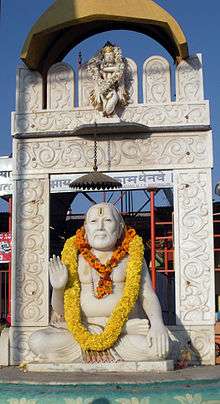Raghavendra Tirtha
| Rāghavēndra Tirtha | |
|---|---|
 | |
| Religion | Hinduism |
| Philosophy | Dvaita |
| Personal | |
| Born |
Venkata Natha 1595 or 1598 or 1601 CE Bhuvanagiri (now in Tamil Nadu) |
| Died |
1671 Mantralayam (now in Andhra Pradesh) |
| Spouse | Sarasvati |
| Children | Lakshminarayanacharya |
| Guru | Sudheendra Tirtha |
| Honors | Parimalacharya, Jagadguru |
| Part of a series on |
| Dvaita |
|---|
| Saints |
| Scriptures |
| Ashta Mathas of Udupi |
| Matha Traya |
| Holy places |
| Haridasas |
| Hinduism portal |
Rāghavēndra Swami (Kan: ರಾಘವೇಂದ್ರ ಸ್ವಾಮಿ) or Rāghavēndra Tirtha (1595–1671 CE), born Venkata Natha, was a renowned Madhwa saint, philosopher and proponent of Dvaita philosophy established by Sri Madhvacharya. He is worshiped as a Guru. He served as the head of the matha in Kumbakonam from 1621 to 1671 and established the Brindavan in Mantralayam in the present-day Andhra Pradesh as an important place of pilgrimage.
Birth and early life
Raghavendra was born as Venkatanatha in the town of Bhuvanagiri, Tamil Nadu in a Kannada Madhva Brahmin family to Thimanna Bhatta and Gopikamba in 1595. He was also called Venkatacharya in honor of Venkateswara. After his initial education under his brother-in-law Lakshmi Narasimhachar in Madurai, Venkatanatha was admitted to the Sri Mutt in Kumbakonam. He married Sarasvati Bai and had a son Lakshminarayanacharya, after which the family moved to Kumbakonam.
Life
Venkatanatha studied under Sudheendra Theertha and was asked to take Sannyasa by him.[1] In 1614, he took sannyasa and adopted the name Raghavendra Theertha, in dedication to Lord Rama. He was also known as a teacher of Sanskrit and the ancient Vedic texts. He was also a musician and played the instrument Veena. In 1621, Raghavendra Theertha succeeded his guru Sudheendra Theertha as the head of the Sri Mutt and served as its head till 1671. He traveled across South India expounding Madhvacharya's Dvaita philosophy and is attributed with a number of miracles. In 1671, after assuring his disciples that he will be in spirit with them for the next seven hundred years, Raghavendra attained Samadhi at Mantralayam.
In 1801, while serving as the Collector of Bellary, Thomas Munro is believed to have come across a vision of Raghavendra Swami.[2][3]
Work and compositions
He wrote a commentary Sudha Parimala on the SrimanNyaya Sudha, an exposition of Dvaita philosophy.[4] His works include Dasha Prakarana, commentaries on six of the ten PrakaraNa-granthas of Madhva, Sutra Prasthaana, works on the brahma-sutra, Rig and Upanishad Prasthaana, Gita Prasthaana, Shri Ramacharitramanjari, Shri Krishnacaritramanjari, Pratah Sankalpa Gadya and Sarvasamarpana Gadya.
In popular culture
Sri Raghavendra Vijaya is a biography on Sri Raghavendra penned by his nephew and devotee Narayanacharya.[5] Sri Raghavendra Stotra is a 32-stanza hymn, sung as a prayer by Appannacharya. Sri Raghavendra Mahatmyam covers the life and devotee experiences with Sri Raghavendra. Sri Raghavendrar was a 1985 Tamil film where Rajnikanth portrays the saint.[6]
See also
References
- ↑ Saints of Karnataka. Chinmaya Mission. 1981. p. 48.
- ↑ Proceedings-Indian History Congress. University of Michigan. 1945. p. 331.
- ↑ Shah, Giriraj (1999). Saints, gurus and mystics of India. 2. Cosmo Publications. p. 473. ISBN 978-81-7020-856-3.
- ↑ "Raghavendra". Retrieved 6 May 2016.
- ↑ "Sri Raghavendra Vijaya". Raghavendra Mutt. Retrieved 6 May 2016.
- ↑ "Rajini acts in front of the camera, never behind it". Rediff. Retrieved 8 November 2015.
